Tribuna of the Uffizi (painting)
 | |
| Artist | Johann Zoffany |
|---|---|
| Year | 1772–78 |
| Medium | Oil painting |
| Dimensions | 123.5 cm × 155.0 cm (48.6 in × 61.0 in) |
| Location | Royal Collection, Windsor Castle |
The Tribuna of the Uffizi (1772–1778) by Johann Zoffany is a painting of the north-east section of the Tribuna room in the Uffizi in Florence, Italy. The painting is part of the United Kingdom's Royal Collection.
Production
In the summer of 1772 Zoffany left London for Florence with a commission from Queen Charlotte to paint 'the Florence Gallery'. (Neither she nor her husband George III ever visited Italy in person.) Felton Hervey who had a large art collection and who knew the Royal family met Zoffany in Florence. He was included in a prominent position in the painting by December 1772.[1] Zoffany was still working on the painting late in 1777, he only finally returned to England in 1779.[2] By this time Hervey had died.[1]
History
Johann Zoffany was a German born painter who had become successful in London. One of his principal patrons was the Royal family. Queen Charlotte had sent Zoffany to Florence where he had agreed to paint the Tribuna of the Uffizi. The agreed price was high and he was paid £300.[2]
Artworks shown
Zoffany has varied the arrangement of the artworks and introduced others from elsewhere in the Medici collection. He gained special privileges, with the help of George, 3rd Earl Cowper (1738–80), and Sir Horace Mann, 1st Baronet (1706–86), such as having seven paintings, including Raphael's Madonna della Sedia, temporarily brought in from the Pitti Palace so that he could paint them in situ in the Tribuna. In thanks Zoffany included a portrait of Cowper looking at his recent acquisition,[3] Raphael's Niccolini-Cowper Madonna (Cowper hoped to sell it on to George III – it is now in the Washington National Gallery of Art), with Zoffany holding it (to the left of the Dancing Faun).
The unframed Samian Sibyl on the floor was acquired for the Medici collection in 1777 - it was a workshop copy of the pendant to Guercino's Libyan Sibyl, recently bought by George III, and may be intended as a compliment to him.
%3B_Zoffany%2C_Johann.jpg)
Paintings
| Zoffany's | Original | Author and title | Where | Current location |
|---|---|---|---|---|
 |  | Annibale Carracci, Venus with a Satyr and Cupids | Left wall | Uffizi, Florence |
 |  | Guido Reni, Charity | Left wall | Palatine Gallery, Pitti Palace, Florence |
 |  | Raphael, Madonna della seggiola | Left wall | Palatine Gallery, Pitti Palace, Florence |
 |  | Correggio, Madonna and Child | Left wall | Uffizi, Florence |
 |  | Justus Sustermans, Portrait of Galileo Galilei | Left wall | Uffizi, Florence |
 | ? | Left wall | ||
 |  | Titian's workshop, Madonna and Child with Saint Catherine | Central wall | Uffizi, Florence |
 |  | Raphael and workshop, St John the Baptist | Central wall | Uffizi, Florence |
 | | Guido Reni, Madonna | Central wall | private collection? |
 | 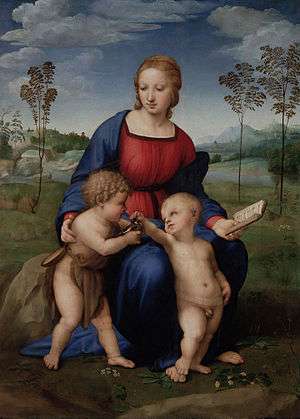 | Raphael, Madonna del cardellino | Central wall | Uffizi, Florence |
 |  | Rubens, The Consequences of War | Central wall | Palatine Gallery, Pitti Palace, Florence |
 |  | Franciabigio (formerly attributed to Raphael), Madonna del Pozzo | Central wall | Uffizi, Florence |
 | ? | Central wall between the legs of the Satyr | ||
 | 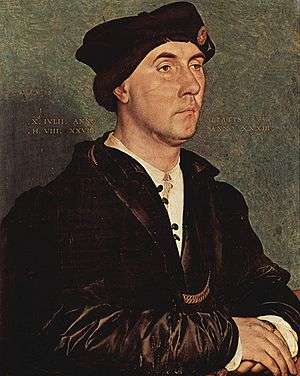 | Hans Holbein, Portrait of Sir Richard Southwell | Central wall | Uffizi, Florence |
 |  | Raphael, Portrait of Perugino | Central wall | Uffizi, Florence |
 | | Perugino's workshop (Niccolò Soggi?), Madonna with Child, Saint Elizabeth and Saint John | Central wall | Uffizi, Florence, still in the Tribuna |
 |  | Guido Reni, Cleopatra | Right wall | Palatine Gallery, Pitti Palace, Florence |
 |  | Rubens, Four Philosophers | Right wall | Palatine Gallery, Pitti Palace, Florence |
 | 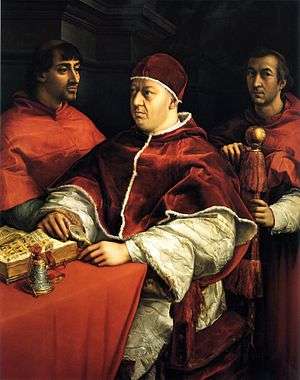 | Raphael, Pope Leo X with Cardinals Giulio de' Medici and Luigi de' Rossi | Right wall | Uffizi, Florence |
 |  | Pietro da Cortona, Abraham and Hagar | Right wall | Kunsthistorisches Museum, Vienna |
 |  | Bartolomeo Manfredi, Tribute to Caesar | Right wall | Uffizi, Florence |
 |  | Cristofano Allori, Hospitality of Saint Julian | Right wall | Palatine Gallery, Pitti Palace, Florence |
 | ? | Right wall right of the Wrestlers | ||
 | Charity? | Right wall | ||
 | ? | Right wall behind the Venus | ||
 | ? (a golden frame behind the man in red at the very right) | Right wall | ||
 |  | Raphael, Niccolini-Cowper Madonna[4] | Lower part | National Gallery of Art, Washington |
 | Guercino's workshop, Samian Sibyl | Lower part | ? | |
 | 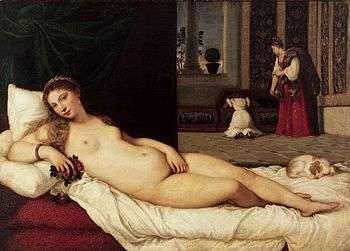 | Titian, Venus of Urbino | Lower part | Uffizi, Florence |
Sculptures and other
Today Medici's Ancient Roman statues are mostly in the main corridors of the Uffizi Gallery, except those which are still in the Tribuna, and except the smaller busts and statuettes (some antique, some pseudo-antique), owned by the National Archaeological Museum and permanently displayed at Villa Corsini a Castello, near Florence. Many of those painted by Zoffany are still to be identified, thou. Other antiquities (Etruscan, Egyptian, Greek) are mostly in the National Archaeological Museum. Some very few Renaissance pieces from the Tribuna are now in the Bargello Museum.
| Zoffany's | Original | Author and title | Where | Current location |
|---|---|---|---|---|
 | | Bust of a young woman, so-called Pautilla | Left shelf | Uffizi Gallery, Florence |
 | Bust of a Roman emperor (?) | Left shelf | ||
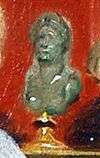 | Bust of Heracles (?) | Left shelf | ||
 | | Ancient Roman bust of a Julio-Claudian woman, so-called Livia (?) | Left shelf | Villa Corsini a Castello, Florence |
 | | Ancient Roman bust of a Julio-Claudian prince | Left shelf | Villa Corsini a Castello, Florence |
 | Bust of Agrippina Minor (?) | Left shelf | ||
 | Bust of a woman (?) | Left shelf | ||
 | | Ancient Roman art, Venus of Aphrodisias | Left shelf | Villa Corsini a Castello, Florence |
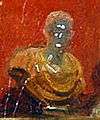 | Bust of a man in alabaster (?) | Left shelf | ||
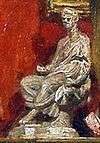 | Seated man (?) | Central shelf | ||
 | Ancient Roman Seated God | Central shelf | National Archaeological Museum, Florence | |
 | Bust of a boy (?) | Central shelf | ||
 | Hard stone object | Central shelf | ||
 | | Bust of a boy, so-called young Nero | Central shelf | Uffizi Gallery, Florence |
 | | Ancient Roman small bust of a Augustus (?) | Central shelf | National Archaeological Museum, Florence |
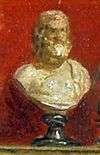 | | Bust of Zeus-Serapis | Central shelf | Villa Corsini a Castello, Florence |
 | Bronze statuette | Central shelf | ||
 | Bust of a man (?) | Central shelf | ||
 | | Cupid with the bow | Central shelf | Uffizi Gallery, Florence |
 | | Ancient Roman bronze statuette of Heracles | Right shelf | National Archaeological Museum, Florence |
 | Bust of a man (?) | Right shelf | ||
 | Canopic jar (?) | Right shelf | ||
 | Bust of a man (?) | Right shelf | ||
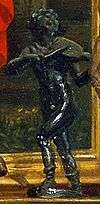 | | Bertoldo di Giovanni, Putto playing the lute | Right shelf | Bargello, Florence |
 | | Ancient Roman statuette of Satyr | Right shelf | Villa Corsini a Castello, Florence |
 | Seated Concordia | Right shelf | National Archaeological Museum, Florence | |
 | | Ancient Roman bust of a Young Satyr | Right shelf | Villa Corsini a Castello, Florence |
 | Ancient Roman art after Lysippus, Heracles and the Nemean Lion | Right shelf | Hermitage, St. Petersburg? | |
 | Seated Tyche of Anthioch | Right shelf | National Archaeological Museum, Florence | |
 | Bust of Bacchus (?) | Right shelf | ||
 | | Ancient Roman art, Cupid and Psyche | Center | Uffizi, Florence |
 | _-_n._2944_-_Il_fauno_danzante._Firenze.jpg) | Ancient Roman art, Dancing Faun | Center | Uffizi, Florence, still in the Tribuna |
 | _and_Jacopo_Ligozzi%2C_tavolo_ottagonale_con_intarsi_in_pietre_dure.jpg) | Jacopo Antelli (Monicca) and Jacopo Ligozzi, Octagonal table with Pietre Dure mosaics | Center | Uffizi, Florence, still in the Tribuna |
 | | Ancient Roman art, Baby Hercules strangling two serpents | Center | Uffizi, Florence, still in the Tribuna |
 | | Ancient Roman art, The Two Wrestlers | Center | Uffizi, Florence, still in the Tribuna |
 |  | Cleomenes, Medici Venus | Center | Uffizi, Florence, still in the Tribuna |
 |  | Baltimore Painter, Apulian krater with Amazonomachy | Lower part | National Archaeological Museum, Florence |
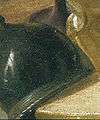 | | Etruscan bronze elm with "button" on top | Lower part | National Archaeological Museum, Florence |
 |  | Ancient Roman art, Arrotino | Lower part | Uffizi, Florence, still in the Tribuna |
 | | Etruscan (with 17th-century implements), Chimera of Arezzo | Lower part | National Archaeological Museum, Florence |
 | | Andrea Briosco workshop, Lucerna in the shape of a Twisting Man | Lower part | Bargello, Florence |
 | | Late antique, Ardaburio's Plate | Lower part | National Archaeological Museum, Florence |
 | Bust of a man (?) | Lower part | ||
 | | Florentine pseudo-antique art, second half of the 16th century, Bronze head of Antinous | Lower part | National Archaeological Museum, Florence |
| | Bronze lucerna (?) | Lower part | ||
 | Etruscan amphora in bucchero | Lower part | National Archaeological Museum, Florence? | |
 |  | Etruscan oinochoe in bucchero | Lower part | National Archaeological Museum, Florence |
 | Etruscan situla in bucchero | Lower part | National Archaeological Museum, Florence? | |
 | Bronze statuette | Lower part | ||
 | | Ancient Greek art, Livorno Torso | Lower part | National Archaeological Museum, Florence |
 | | Ancient Egyptian art, Cube statue of Ptahmose | Lower part | National Archaeological Museum, Florence |
 | | Etruscan funerary urn probably Volterra production (?) | Lower part | under the Venus of Urbino |
Persons shown
All the connoisseurs, diplomats and visitors to Florence portrayed are identifiable, making the painting a combination of the British 18th-century conversation piece or informal group portrait genre, with that of the predominantly Flemish 17th-century tradition of gallery views and wunderkammers. However, this inclusion of so many recognisable portraits led to criticism at the time by Zoffany's royal patrons, and by Horace Walpole, who called it "a flock of travelling boys, and one does not know nor care whom."[5]
Pietro Bastianelli, curator of the Uffizi Gallery, shows the Venus of Urbino di Titian to Mr. Gordon, Thomas Patch (probably the man touching the Venus) and Felton Hervey, who's looking back towards Sir John Taylor e Sir Horace Mann.
Sources
| Wikimedia Commons has media related to Uffizi Tribuna (Zoffany). |
- 1 2 The Hon Felton Harvey by John Faynam, National Trust, retrieved 4 June 2014
- 1 2 Tribuna of the Uffizi, Royal Collection, accessed 4 June 2014
- ↑ A key to the people shown, oneonta.edu, retrieved 17 October 2014
- ↑ This painting was owned by Zoffany at the moment: this explains its prominence.
- ↑ Letter to Mann, 12 November, 1779
- Royal Collection
- William L. Pressly, Genius Unveiled: The Self-Portraits of Johan Zoffany, The Art Bulletin, Vol. 69, No. 1. (Mar., 1987), pp. 88–101.
- John Anthony Nicholls: Das Galeriebild im 18. Jahrhundert und Johann Zoffanys "Tribuna". Ph.D., Bonn University 2006 PDF
- Desmond Shawe-Taylor, The Conversation Piece: Scenes of Fashionable Life (2009)